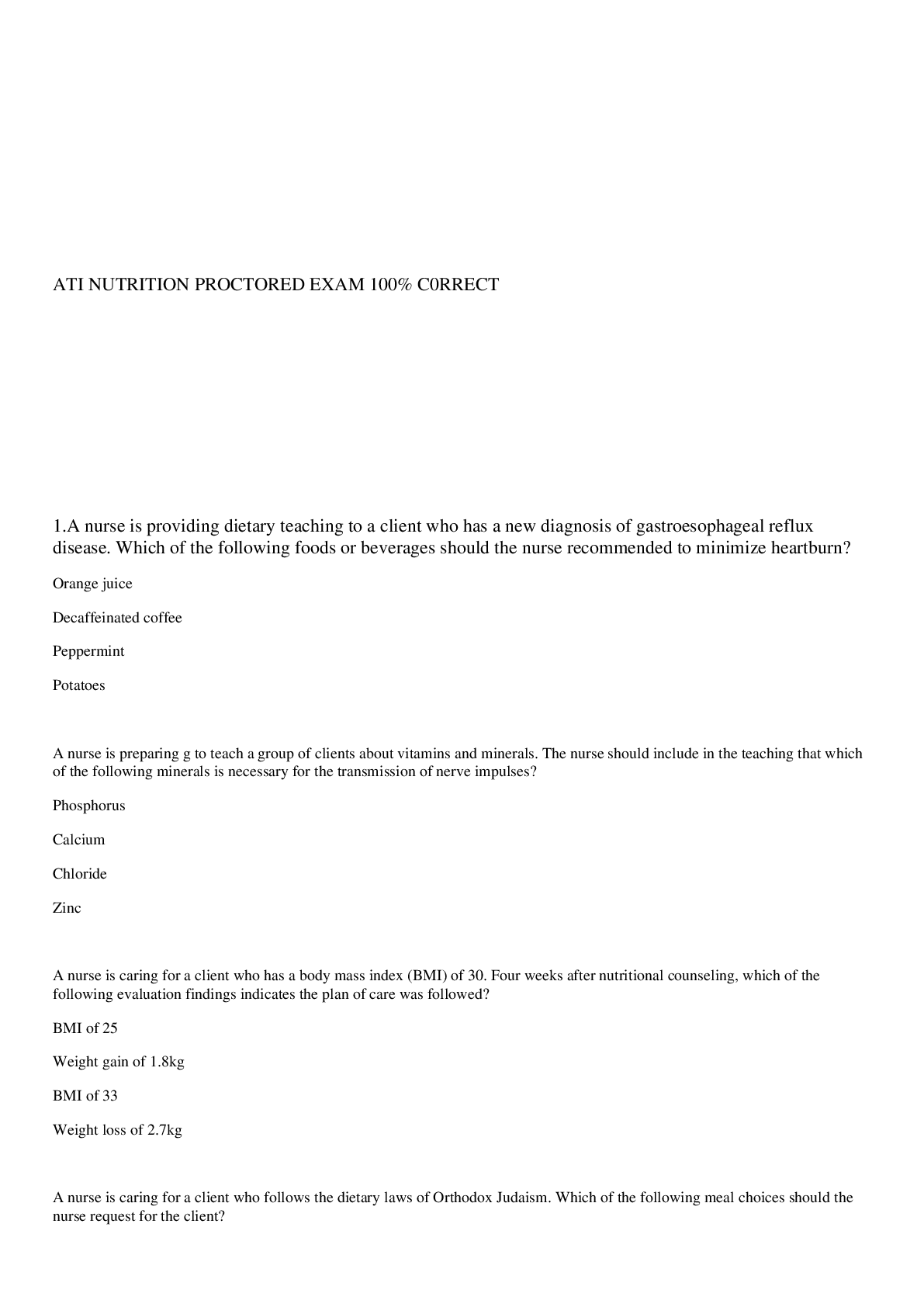*NURSING > QUESTIONS & ANSWERS > Horry-Georgetown Technical College - NURSING 220 (COMPLETE STUDY GUIDE) (All)
Horry-Georgetown Technical College - NURSING 220 (COMPLETE STUDY GUIDE)
Document Content and Description Below
Study Guide Test 1 Chapter 3: (Seven) 1. Skilled Interviewing Mr. W. is a 51-year-old auto mechanic who comes to the emergency room wanting to be checked out for the symptom of chest pain. As you l... isten to him describe his symptom in more detail, you say "Go on," and later, "Mm-hmmm." This is an example of which of the following skilled interviewing techniques? A) Echoing B) Nonverbal communication C) Facilitation D) Empathic response Mrs. T. comes for her regular visit to the clinic. She is on your schedule because her regular provider is on vacation and she wanted to be seen. You have heard about her many times from your colleague and are aware that she is a very talkative person. Which of the following is a helpful technique to improve the quality of the interview for both the provider and the patient? A) Allow the patient to speak uninterrupted for the duration of the appointment. B) Briefly summarize what you heard from the patient in the first 5 minutes and then try to have her focus on one aspect of what she told you. C) Set the time limit at the beginning of the interview and stick with it, no matter what occurs in the course of the interview. D) Allow your impatience to show so that the patient picks up on your nonverbal cue that the appointment needs to end. When you enter your patient's examination room, his wife is waiting there with him. Which of the following is most appropriate? A) Ask if it's okay to carry out the visit with both people in the room. B) Carry on as you would ordinarily. The permission is implied because his wife is in the room with him. C) Ask his wife to leave the room for reasons of confidentiality. D) First ask his wife what she thinks is going on. 2. interviewing sequence Suzanne, a 25 year old, comes to your clinic to establish care. You are the student preparing to go into the examination room to interview her. Which of the following is the most logical sequence for the patient-provider interview? A) Establish the agenda, negotiate a plan, establish rapport, and invite the patient's story. B) Invite the patient's story, negotiate a plan, establish the agenda, and establish rapport. C) Greet the patient, establish rapport, invite the patient's story, establish the agenda, expand and clarify the patient's story, and negotiate a plan. D) Negotiate a plan, establish an agenda, invite the patient's story, and establish rapport. A patient complains of knee pain on your arrival in the room. What should your first sentence be after greeting the patient? A) How much pain are you having? B) Have you injured this knee in the past? C) When did this first occur? D) Could you please describe what happened? For which of the following patients would a comprehensive health history be appropriate? A) A new patient with the chief complaint of "I sprained my ankle" B) An established patient with the chief complaint of "I have an upper respiratory infection" C) A new patient with the chief complaint of "I am here to establish care" D) A new patient with the chief complaint of "I cut my hand" 3. 7 attributes of symptoms Alexandra is a 28-year-old editor who presents to the clinic with abdominal pain. The pain is a dull ache, located in the right upper quadrant, that she rates as a 3 at the least and an 8 at the worst. The pain started a few weeks ago, it lasts for 2 to 3 hours at a time, it comes and goes, and it seems to be worse a couple of hours after eating. She has noticed that it starts after eating greasy foods, so she has cut down on these as much as she can. Initially it occurred once a week, but now it is occurring every other day. Nothing makes it better. From this description, which of the seven attributes of a symptom has been omitted? A) Setting in which the symptom occurs B) Associated manifestations C) Quality D) Timing Jason is a 41-year-old electrician who presents to the clinic for evaluation of shortness of breath. The shortness of breath occurs with exertion and improves with rest. It has been going on for several months and initially occurred only a couple of times a day with strenuous exertion; however, it has started to occur with minimal exertion and is happening more than a dozen times per day. The shortness of breath lasts for less than 5 minutes at a time. He has no cough, chest pressure, chest pain, swelling in his feet, palpitations, orthopnea, or paroxysmal nocturnal dyspnea. Which of the following symptom attributes was not addressed in this description? A) Severity B) Setting in which the symptom occurs C) Timing D) Associated manifestations The following information is recorded in the health history: "The patient has had abdominal pain for 1 week. The pain lasts for 30 minutes at a time; it comes and goes. The severity is 7 to 9 on a scale of 1 to 10. It is accompanied by nausea and vomiting. It is located in the mid-epigastric area." Which of these categories does it belong to? A) Chief complaint B) Present illness C) Personal and social history D) Review of systems The following information is recorded in the health history: "Patient denies chest pain, palpitations, orthopnea, and paroxysmal nocturnal dyspnea." Which category does it belong to? A) Chief complaint B) Present illness C) Personal and social history D) Review of systems The following information is recorded in the health history: "The patient completed 8th grade. He currently lives with his wife and two children. He works on old cars on the weekend. He works in a glass factory during the week." Which category does it belong to? A) Chief complaint B) Present illness C) Personal and social history D) Review of systems 4. Types of challenging patients Mrs. H. comes to your clinic, wanting antibiotics for a sinus infection. When you enter the room, she appears to be very angry. She has a raised tone of voice and states that she has been waiting for the past hour and has to get back to work. She states that she is unimpressed by the reception staff, the nurse, and the clinic in general and wants to know why the office wouldn't call in an antibiotic for her. Which of the following techniques is not useful in helping to calm this patient? A) Avoiding admission that you had a part in provoking her anger because you were late B) Accepting angry feelings from the patient and trying not to get angry in return C) Staying calm D) Keeping your posture relaxed You have just asked a patient how he feels about his emphysema. He becomes silent, folds his arms across his chest and leans back in his chair, and then replies, "It is what it is." How should you respond? A) "You seem bothered by this question." B) "Next, I would like to talk with you about your smoking habit." C) "Okay, let's move on to your other problems." D) "You have adopted a practical attitude toward your problem." Mrs. R. is a 92-year-old retired teacher who comes to your clinic accompanied by her daughter. You ask Mrs. R. why she came to your clinic today. She looks at her daughter and doesn't say anything in response to your question. This is an example of which type of challenging patient? A) Talkative patient B) Angry patient C) Silent patient D) Hearing-impaired patient 5. Techniques for interviewing A patient is describing a very personal part of her history very quickly and in great detail. How should you react to this? A) Write down as much as you can, as quickly as possible. B) Ask her to repeat key phrases or to pause at regular intervals, so you can get almost every word. C) Tell her that she can go over the notes later to make sure they are accurate. D) Push away from the keyboard or put down your pen and listen . A patient tells you about her experience with prolonged therapy for her breast cancer. You comment, "That must have been a very trying time for you." What is this an example of? A) Reassurance B) Empathy C) Summarization D) Validation You are interviewing an elderly woman in the ambulatory setting and trying to get more information about her urinary symptoms. Which of the following techniques is not a component of adaptive questioning? A) Directed questioning: starting with the general and proceeding to the specific in a manner that does not make the patient give a yes/no answer B) Reassuring the patient that the urinary symptoms are benign and that she doesn't need to worry about it being a sign of cancer C) Offering the patient multiple choices in order to clarify the character of the urinary symptoms that she is experiencing D) Asking her to tell you exactly what she means when she states that she has a urinary tract infection The following information is recorded in the health history: "I feel really tired." Which category does it belong to? A) Chief complaint B) Present illness C) Personal and social history D) Review of systems You are beginning the examination of a patient. All of the following areas are important to observe as part of the General Survey except: A) Level of consciousness B) Signs of distress C) Dress, grooming, and personal hygiene D) Blood pressure Common or concerning symptoms to inquire about in the General Survey and vital signs include all of the following except: A) Changes in weight B) Fatigue and weakness C) Cough D) Fever and chills 6. Use of interpreters When using an interpreter to facilitate an interview, where should the interpreter be positioned? A) Behind you, the examiner, so that the lips of the patient and the patient's nonverbal cues can be seen B) Next to the patient, so the examiner can maintain eye contact and observe the nonverbal cues of the patient C) Between you and the patient so all parties can make the necessary observations D) In a corner of the room so as to provide minimal distraction to the interview Chapter 4: (Seven) 1. Vital Signs ht/wt 2. General Survey 3. Blood Pressure You are seeing an older patient who has not had medical care for many years. Her vital signs taken by your office staff are: T 37.2, HR 78, BP 118/92, and RR 14, and she denies pain. You notice that she has some hypertensive changes in her retinas and you find mild proteinuria on a urine test in your office. You expected the BP to be higher. She is not on any medications. What do you think is causing this BP reading, which doesn't correlate with the other findings? A) It is caused by an "auscultatory gap." B) It is caused by a cuff size error. C) It is caused by the patient's emotional state. D) It is caused by resolution of the process which caused her retinopathy and kidney problems. A 55-year-old bookkeeper comes to your office for a routine visit. You note that on a previous visit for treatment of contact dermatitis, her blood pressure was elevated. She does not have prior elevated readings and her family history is negative for hypertension. You measure her blood pressure in your office today. Which of the following factors can result in a false high reading? A) Blood pressure cuff is tightly fitted. B) Patient is seated quietly for 10 minutes prior to measurement. C) Blood pressure is measured on a bare arm. D) Patient's arm is resting, supported by your arm at her mid-chest level as you stand to measure the blood pressure. Despite having high BP readings in the office, Mr. Kelly tells you that his readings at home are much lower. He checks them twice a day at the same time of day and has kept a log. How do you respond? A) You diagnose "white coat hypertension." B) You assume he is quite nervous when he comes to your office. C) You question the accuracy of his measurements. D) You question the accuracy of your measurements. 4. BMI (obese/anorexia) A 15-year-old high school sophomore and her mother come to your clinic because the mother is concerned about her daughter's weight. You measure her daughter's height and weight and obtain a BMI of 19.5 kg/m2. Based on this information, which of the following is appropriate? A) Refer the patient to a nutritionist and a psychologist because the patient is anorexic. B) Reassure the mother that this is a normal body weight. C) Give the patient information about exercise because the patient is obese. D) Give the patient information concerning reduction of fat and cholesterol in her diet because she is obese. A 30-year-old sales clerk comes to your office wanting to lose weight; her BMI is 30.0 kg/m2. What is the most appropriate amount for a weekly weight reduction goal? A) .5 to 1 pound per week B) 1 to 2.5 pounds per week C) 2.5 to 3.5 pounds per week D) 3.5 to 4.5 pounds per week Mr. Curtiss has a history of obesity, diabetes, osteoarthritis of the knees, HTN, and obstructive sleep apnea. His BMI is 43 and he has been discouraged by his difficulty in losing weight. He is also discouraged that his goal weight is 158 pounds away. What would you tell him? A) "When you get down to your goal weight, you will feel so much better." B) "Some people seem to be able to lose weight and others just can't, no matter how hard they try." C) "We are coming up with new medicines and methods to treat your conditions every day." D) "Even a weight loss of 10% can make a noticeable improvement in the problems you mention." 5. Patient Positioning and comfort You arrive at the bedside of an elderly woman who has had a stroke, affecting her entire right side. She cannot speak (aphasia). You are supposed to examine her. You notice that the last examiner left her socks at the bottom of the bed, and although sensitive areas are covered by a sheet, the blanket is heaped by her feet at the bottom of the bed. What would you do next? A) Carry out your examination, focusing on the neurologic portion, and then cover her properly. B) Carry out your examination and let the nurse assigned to her "put her back together." C) Put her socks back on and cover her completely before beginning the evaluation. D) Apologize for the last examiner but let the next examiner dress and cover her. Chapter 7: (Eight) 1. Headaches (types) Mrs. Buckley is a 75-year-old widow who wants you to look at her teeth because over the past 2 weeks she has had right-sided jaw pain when eating. It does not occur otherwise. She also has had a headache. Which of the following should be considered? A) Palpation of her temples B) Dental referral C) Ultrasound of the gallbladder 2. Exophthalmos A 29-year-old physical therapist presents for evaluation of an eyelid problem. On observation, the right eyeball appears to be protruding forward. Based on this description, what is the most likely diagnosis? A)Exophthalmos 3. Hordeolum (STY) 4. Chalazion Inspection of a client's eyelids reveals significant lid swelling, moderate redness, but little pain. Which of the following would the nurse suspect? A) Chalazion 5. Subconjunctival hemorrhage 6. Pterygium A 67 year old lawyer comes to your clinic for an annual examination. He denies any history of eye trauma. He denies visual changes. You inspect his eyes and find a triangular thickening of the bulbar conjunctiva across the outer surface of the cornea. He has normal pupillary reaction to light and accommodation. Based on this description, what is the most likely diagnosis? A) Pterygium 7. Retinal detachment A sudden painless, unilateral vision loss may be caused by which of the following? a)Acute Glucoma b)uveitis c) retinal detachment d)corneal ulcer 8. External otitis 9. Lymph node 10. Pupil dilation 11. Visual Acuity Chapter 8: (Seven) 1. Asthma Tachypnea, use of accessory muscles, prolonged expiration, intercostal retraction, decreased breath sounds, and expiratory wheezes are all symptomatic of: (A) Pleural effusion (B) Atelectasis (C) Asthma (D) Bronchitis During assessment, the nurse would expect which part of the body to indicate central cyanosis in a client with a severe asthma attack? – Oral Mucosa 2. COPD 3. Chest Landmarks for procedures 4. Respiratory Distress Which of the following occurs with respiratory distress? a) Speaking in sentances of 10-20 words b) Skin between the ribs moves inward with inspiration c) neck muscles are relaxed d) patient torso leans posteriorly A 25-year-old type 1 diabetic clerk presents to the emergency room with shortness of breath and states that his blood sugar was 605 at home. You diagnose the patient with diabetic ketoacidosis. What is the expected pattern of breathing? A) Normal B) Rapid and shallow C) Rapid and deep D) Slow 5. Heart Failure You are observing a patient with heart failure and notice that there are pauses in his breathing. On closer examination, you notice that after the pauses the patient takes progressively deeper breaths and then progressively shallower breaths, which are followed by another apneic spell. The patient is not in any distress. You make the diagnosis of: A) Ataxic (Biot's) breathing B) Cheyne-Stokes respiration C) Kussmaul's respiration D) COPD with prolonged expiration 6. Bronchitis When crackles, wheezes or rhonchi clear with a cough, which of the following is a likely etiology? A) Bronchitis B) Cystic Fibrosis C) Heart Failure D) Simple asthma Chapter 9: (Seven) 1. Murmurs (mitral, systolic, diastolic) During cardiac examination you notice a new parasternal systolic murmur of 2/6 intensity. On palpation, the PMI is slightly higher than usual. What do you suspect? A) Mammary souffle B) Mitral stenosis C) Mitral regurgitation D) Aortic insufficiency Mr. Chin is an 82-year-old man who comes to your office for a routine check. On examination, you notice a somewhat high-pitched murmur in the second right intercostal space during systole. It does not radiate and the rest of his examination is normal for his age. Which is true of the most likely cause of this murmur? A) It often decreases carotid upstroke. B) It carries with it increased risk for cardiovascular disease. C) It is usually accompanied by an S3 gallop. D) It is found in 10% of otherwise normal elderly patients. 2. PMI 3. Heart Sounds Ms. Wright comes to your office, complaining of palpitations. While checking her pulse you notice an irregular rhythm. When you listen to her heart, every fourth beat sounds different. It sounds like a triplet rather than the usual "lub dup." How would you document your examination? A) Regular rate and rhythm B) Irregularly irregular rhythm C) Regularly irregular rhythm D) Bradycardia A 49-year-old truck driver comes to the emergency room for shortness of breath and swelling in his ankles. He is diagnosed with congestive heart failure and admitted to the hospital. You are the student assigned to do the patient's complete history and physical examination. When you palpate the pulse, what do you expect to feel? A) Large amplitude, forceful B) Small amplitude, weak C) Normal D) Bigeminal 4. Grading Chapter 12 Arterial and Venous Insufficiency – assessment tests and complications of 1. If someone has Peripheral Artery Disease (PAD) what should you always do? 2. What are some arterial issues with our older population? 3. What is Claudication? 4. How is claudication brought on and how is it relieved? 5. If someone has claudication, where do they usually have pain? 6. What are the three types of pain patients who have claudication normally experience? 7. What happens when you have varicose veins and what are you at risk for? 8. What does the Allen Test evaluate? 9. What is the process for doing an Allen Test? 10. What are four things to look for during an assessment for venous insufficiency? 11. A patient you are seeing complains of a sore on his lower leg that does not seem to get better. Based on examination findings, you suspect venous insufficiency. Which of the clinical findings below would suggest venous insufficiency as the cause of his problem? A. Leg discomfort is exacerbated by dependency B. Hyperpigmentation is present around the lower calf area C. Ulceration is present on the medial side of the ankle D. Affected leg feels warm to the touch 12. A patient you are seeing complains of severe pain in her right foot. Based on examination findings, you suspect arterial insufficiency. Which of the clinical findings below would suggest arterial insufficiency as the cause of her problem? A. Brisk posterior tibial and dorsalis pedis pulses B. Pallor of the foot upon elevation C. Pitting edema of the lower leg D. Warmth of the right foot 13. The client has a 1+ dorsal pedal pulse and a nonpalpable posterior tibial pulse on the right. The extremity is pale and painful, a skin ulceration is forming. This description is most consistent with: a. Arterial insufficiency to the right leg b. Femoral arteritis c. Coarctation of the aorta d. Venous insufficiency to the right leg. 14. A 55-year-old secretary with a recent history of breast cancer, for which she underwent surgery and radiation therapy, and a history of hypertension comes to your office for a routine checkup. Which of the following aspects of the physical are important to note when assessing the patient for peripheral vascular disease in the arm? a. Femoral pulse, popliteal pulse b. Dorsalis pedis pulse, posterior tibial pulse c. Carotid pulse d. Radial pulse, brachial pulse 15. You are performing a routine check-up on an 81-year-old retired cotton farmer in the vascular surgery clinic. You note that he has a history of chronic arterial insufficiency. Which of the following physical examination findings in the lower extremities would be expected with this disease? a. Normal pulsation b. Normal temperature c. Marked edema d. Thin, shiny, atrophic skin 16. A 77-year-old retired nurse has an ulcer on a lower extremity that you are asked to evaluate when you do your weekly rounds at a local long-term care facility. All of the following are responsible for causing ulcers in the lower extremities except for which condition? a. Arterial insufficiency b. Venous insufficiency c. Diminished sensation in pressure points d. Hypertension 17. Which of the following is true of assessment of the vascular system in the elderly? A) Fewer than one third of patients with peripheral vascular disease have symptoms of claudication. B) An aortic width of 2.5 cm is abnormal. C) Bruits are commonly benign findings. D) Orthostatic blood pressure and pulse are not useful in this population An 18-year-old college freshman presents to the clinic for evaluation of gastroenteritis. You measure the patient's temperature and it is 104 degrees Fahrenheit. What type of pulse would you expect to feel during his initial examination? A) Large amplitude, forceful B) Small amplitude, weak C) Normal D) Bigeminal Chapter 20 (7) 1. Syncope Claire's daughter brings her in today after Claire fell at her home. Which assessments are indicated at this time? A) Orthostatic vital signs B) Review of her medications C) Assessment of gait and balance D) All of the above A 78-year-old retired seamstress comes to the office for a routine check-up. You obtain an ECG (electrocardiogram) because of her history of hypertension. You diagnose a previous myocardial infarction and ask her if she had any symptoms related to this. Which of the following symptoms would be more common in this patient's age group for an acute myocardial infarction? A) Chest pain B) Syncope C) Pain radiating into the left arm D) Pain radiating into the jaw 2. Immunizations Which of the following booster immunizations is recommended in the older adult population? A) Tetanus B) Diphtheria C) Measles D) Mumps 3. Safety- home, etc You are asked to perform a home safety assessment for an 87-year-old retired farmer who lives by himself. Which of the following is not considered to be an increased risk for falls? A) Loose electrical cords B) Slippery or irregular surfaces C) Chairs at awkward angles D) Bright lighting Mrs. Glynn is 90 years old and lives alone. She is able to bathe, dress, prepare her food, and transfer from bed to chair independently. She has children in the area who help her with her medications and transportation needs. Which of the following is considered an instrumental activity of daily living? A) Bathing B) Dressing C) Preparing food D) Transferring from bed to chair Mr. White's son brings him in today because he notes that Mr. White has not been himself lately. He seems forgetful and has not taken care of himself as he normally does. He has reported falling twice at home to his son and has telephoned late at night because of insomnia. His blood pressure and diabetes have been difficult to control and his warfarin dosing has become more difficult. Which of the following should you suspect? A) Alzheimer's dementia B) Alcohol use C) Urinary tract infection D) Stroke 4. Age related Physiological changes dental, vision, hearing, You are examining an elderly man and notice the following: decreased vibration sense in the feet and ankles, diminished gag reflex, right patellar reflex less than the left, and diminished abdominal reflexes. Which of these is abnormal? A) Decreased vibration sense B) Diminished gag reflex C) Diminished right patellar reflex compared to the left D) Diminished abdominal reflexes A 72-year-old retired truck driver comes to the clinic with his wife for evaluation of hearing loss. He has noticed some decreased ability to hear what his wife and grandchildren are saying to him. He admits to lip-reading more. He has a history of noise exposure in his young adult years: He worked as a sound engineer at a local arena and had to attend a lot of concerts. Based on this information, what is the most likely finding regarding his hearing acuity? A) Loss of acuity for middle-range sounds B) Increase of acuity for low-range sounds C) Loss of acuity for high-range sounds D) Increase of acuity for high-range sounds An 89-year-old retired school principal comes for an annual check-up. She would like to know whether or not she should undergo a screening colonoscopy. She has never done this before. Which of the following factors should not be considered when discussing whether she should go for this screening test? A) Life expectancy B) Time interval until benefit from screening accrues C) Patient preference D) Current age of patient Which of the following represents age-related changes in the lungs? A) Decrease in chest wall compliance B) Speed of expiration increases C) Increase in respiratory muscle strength D) Increased elastic recoil of lung tissue Blood pressure abnormalities found more commonly in Western elderly include which of the following? A) Isolated elevation of the diastolic BP B) Narrow pulse pressure C) Elevation of the systolic BP D) Elevation of the BP with standing Mrs. Stanton is a 79-year-old widow who presents to your office for a routine BP visit. You note a new pulsatile mass in the right neck at the carotid artery. Which of the following is the most likely cause for this? A) Anxiety B) Carotid artery aneurysm C) Kinking of the artery D) Tortuous aorta 5. Changes in men/woman Which of the following is commonly seen in aging men? A) Erectile dysfunction in 20% of all men B) Testicles ride higher within the scrotum C) Strong response to visual erotic cues D) Persistent sexual interest Which of the following accompanies decreased ovarian function? A) Increased sleep B) Diminution of sexual interest C) Enlargement of the clitoris D) Decrease in vaginal secretions [Show More]
Last updated: 2 years ago
Preview 1 out of 16 pages

Buy this document to get the full access instantly
Instant Download Access after purchase
Buy NowInstant download
We Accept:

Reviews( 0 )
$10.00
Can't find what you want? Try our AI powered Search
Document information
Connected school, study & course
About the document
Uploaded On
Apr 19, 2020
Number of pages
16
Written in
Additional information
This document has been written for:
Uploaded
Apr 19, 2020
Downloads
0
Views
137

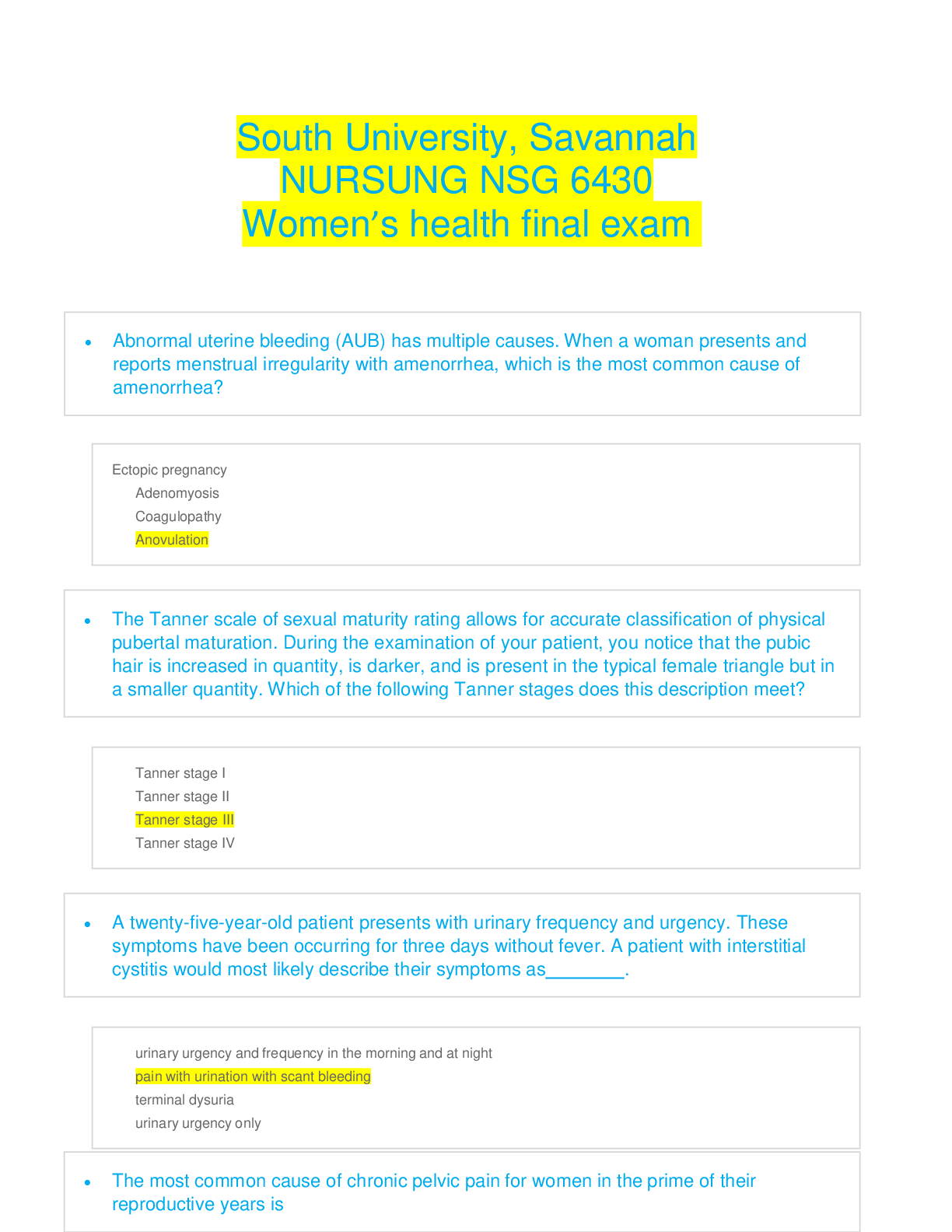

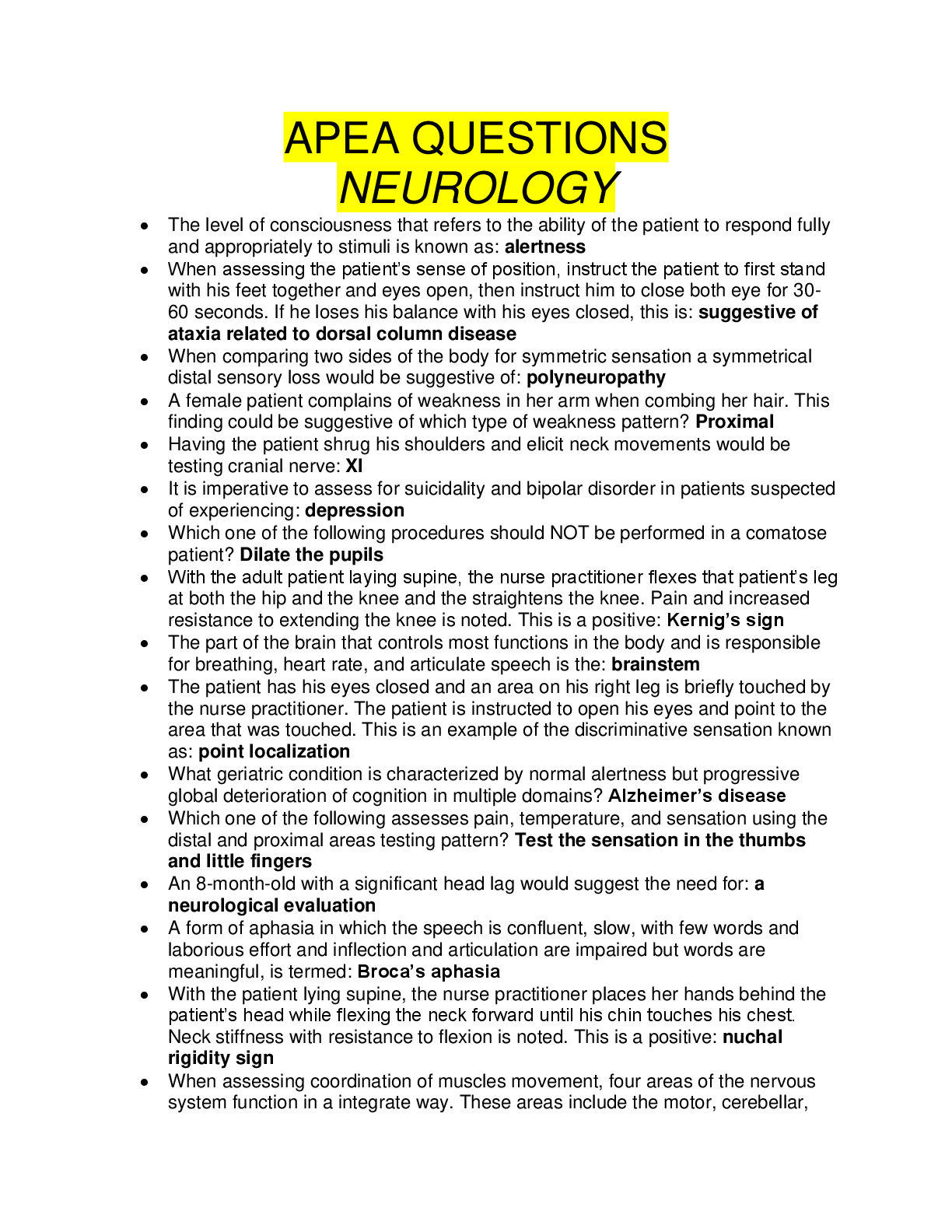

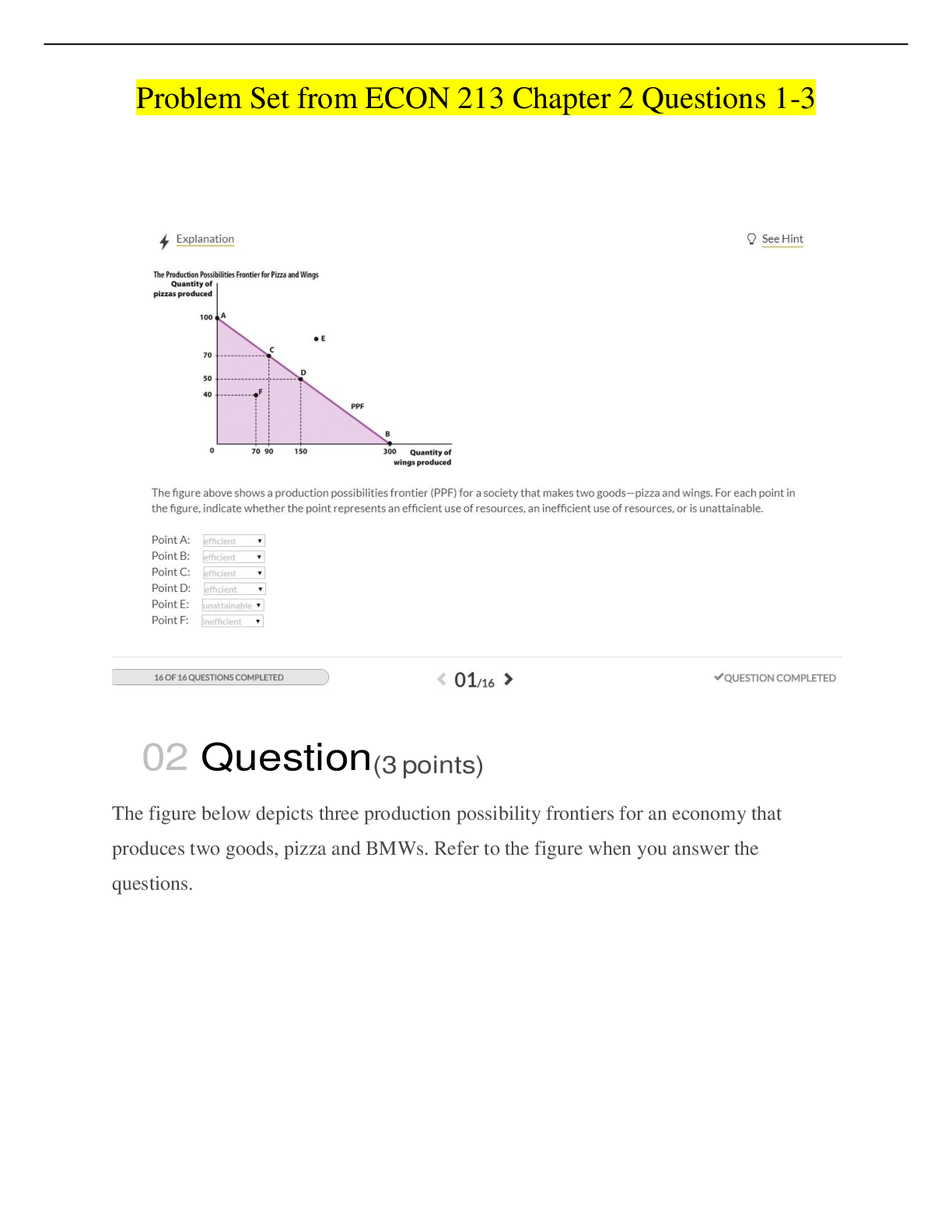
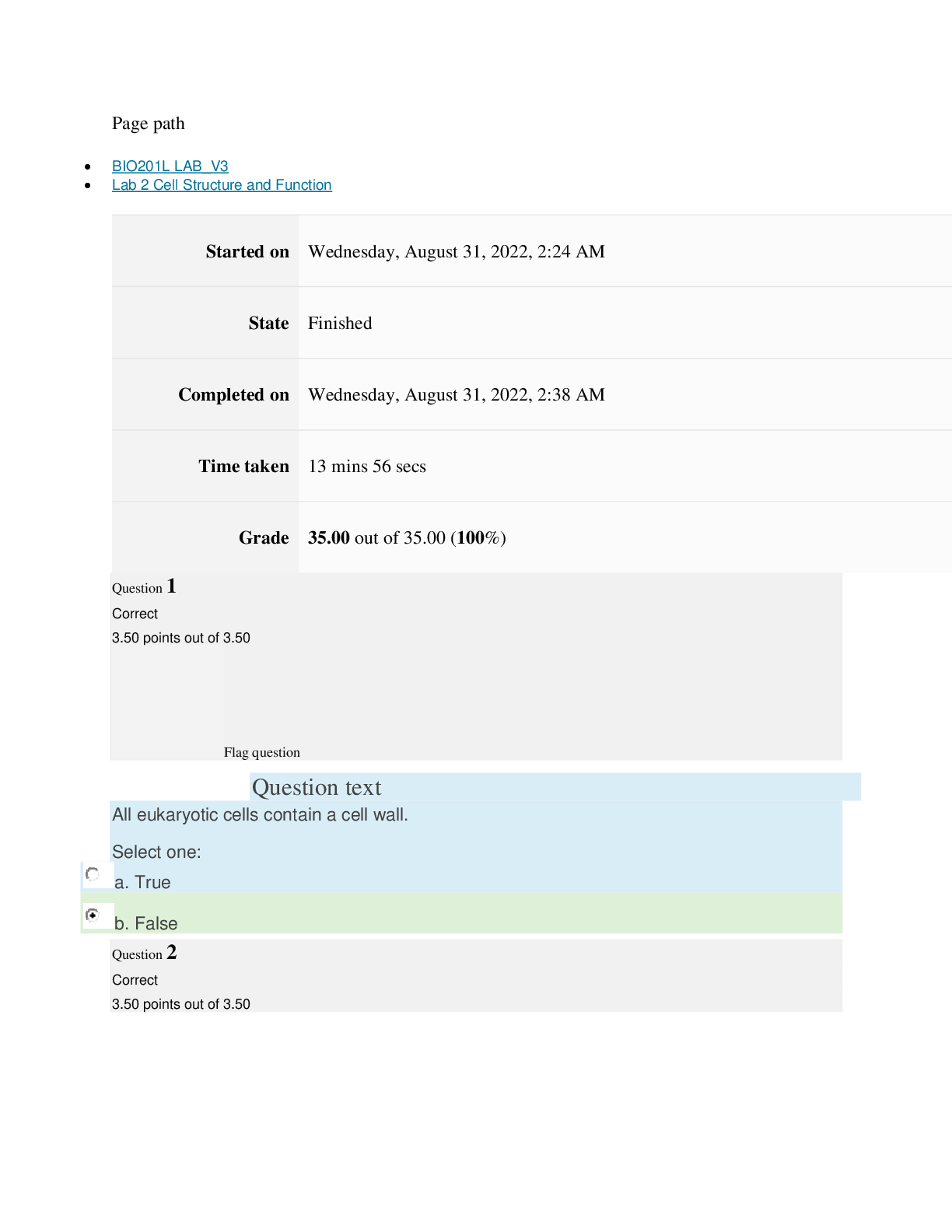

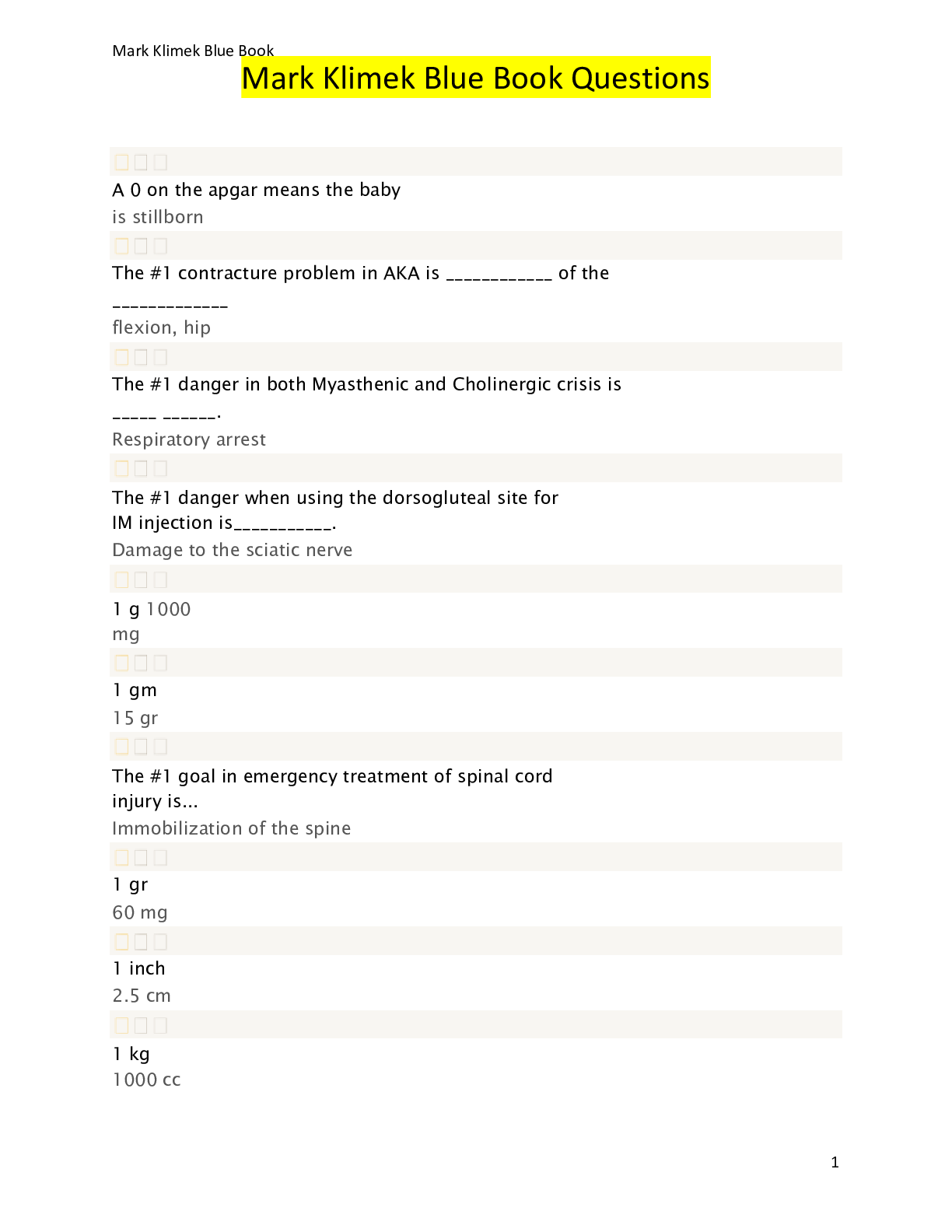

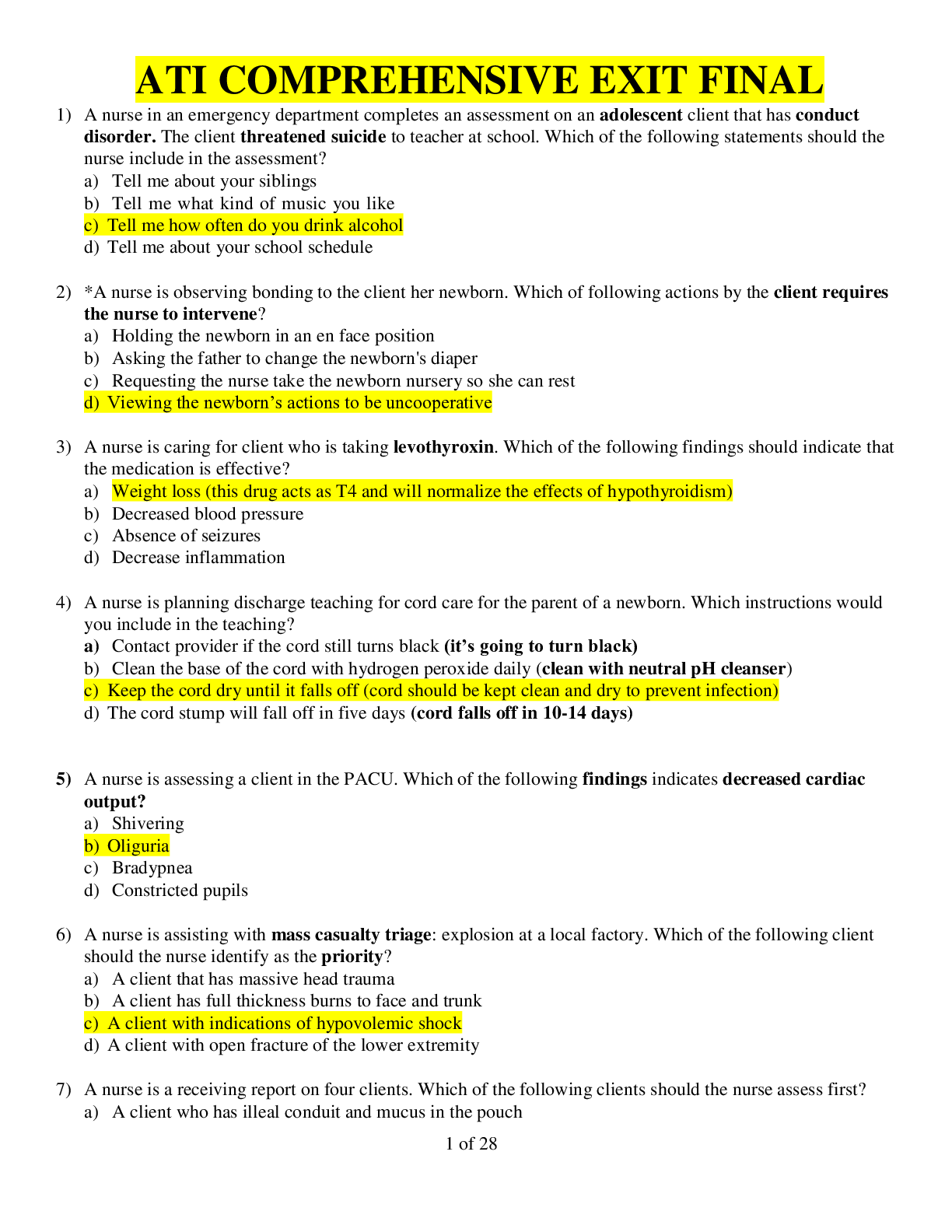


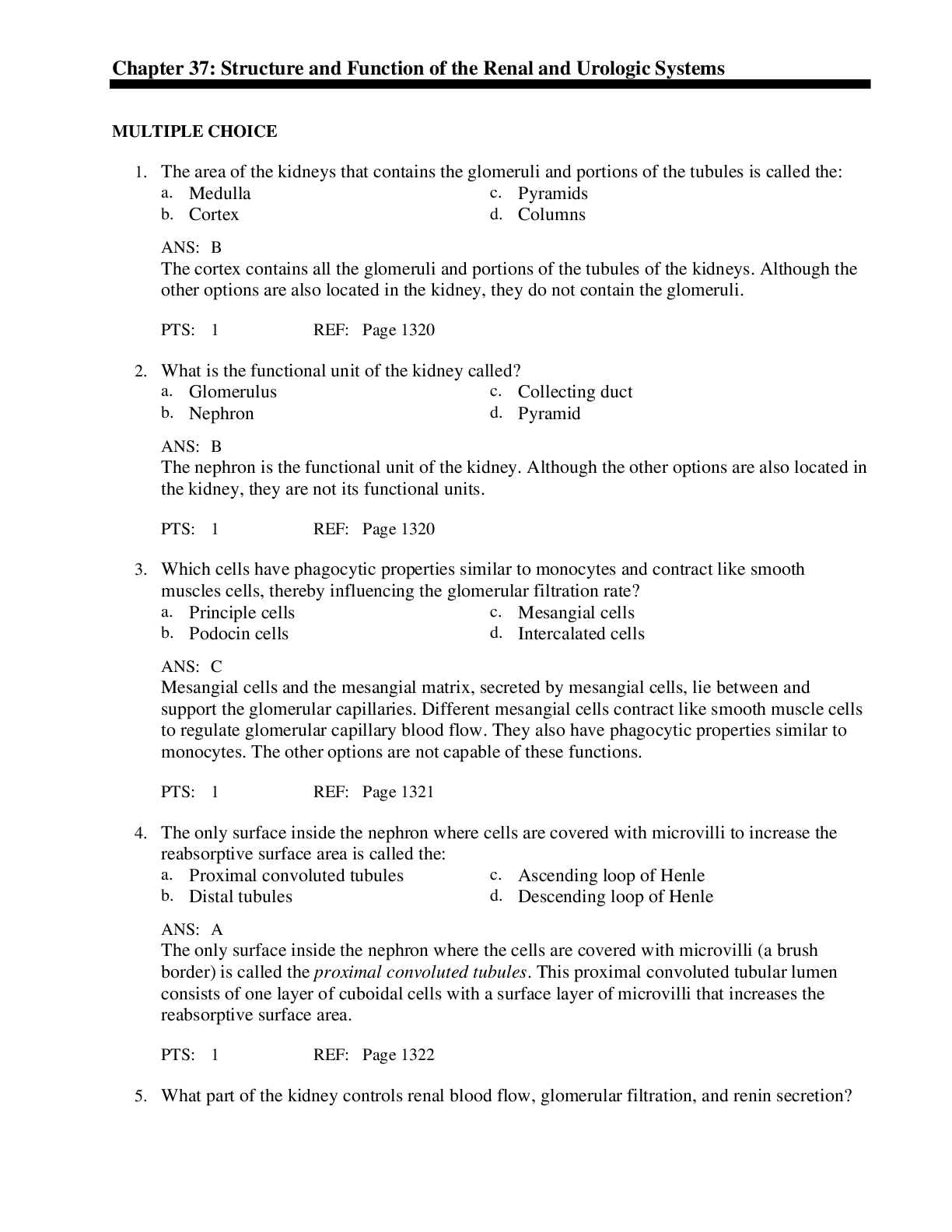






 Correct Study Guide, Download to Score A.png)

